Impatiens are one of the most beloved and useful annual plants available to home gardeners. They can be used as a filler in large seasonal planters, as a groundcover in the garden, or as an edging plant to add seasonal color. The flowering period is exceptionally long from mid-spring to the first frost of the fall. These plants can be planted as annuals in just about any growing zone, which also means they can be exposed to a large variety of pests. Nematodes, sap-sucking insects, mites, beetles, and mammals are all potential threats to Impatiens.
Common Impatiens Pests
Root Knot Nematodes
Root Knot Nematodes are microscopic worms found in the soil. Known scientifically as Meloidogyne, this pest feeds on the roots of Impatiens, causing knots or galls in the roots themselves. The damage prevents the plant from taking up nutrients and water, causing either a slow or sometimes startingly rapid decline in growth or health. Root Knot Nematodes are often found in mild climates with winters not cold enough to freeze and kill off the eggs in the soil.
The usual signs of nutrient deficiency are seen first: yellowing of the foliage, slowed plant growth, failure to flower properly, and flowers dropping off the plant without opening. The only way to determine if the damage is from Nematodes is to dig up the plant and examine the roots under a microscope.
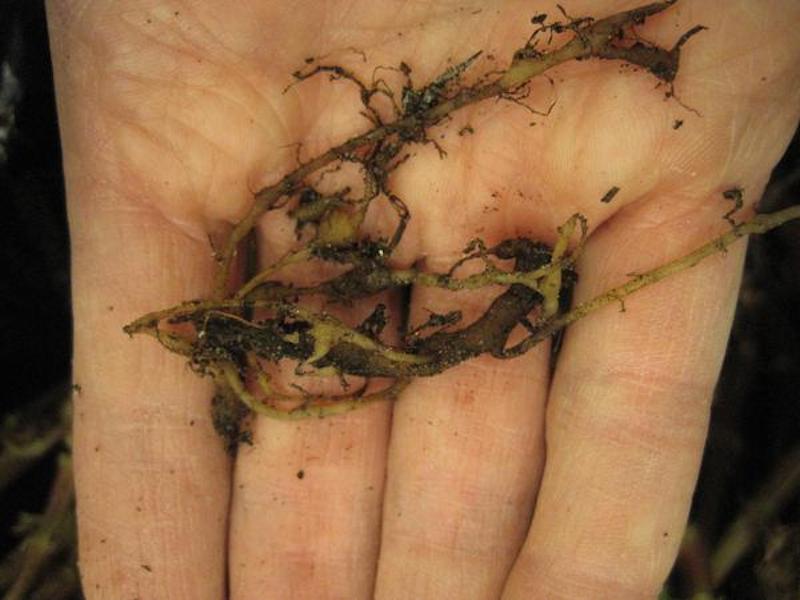
Photo courtesy of NC State University Plant Disease and Insect Clinic
Treating Root Knot Nematodes on Impatiens
The best way to treat Nematodes on Impatiens is to completely remove the plant before the Nematodes can spread. If other plants begin to show similar signs, the Root Knot Nematode is present in the soil and no other plants in the Impatien family should be planted there.
Preventing Root Knot Nematodes on Impatiens
Nematodes prefer sandy, less nutritious soil. Amending sandy soil with organic material will help to improve the texture and water-holding ability. Rotating plants in a garden also is effective in keeping Root Knot Nematodes from settling in one area. Always inspect any new plants brought into the garden carefully. Any that have suspected damage from Root Knot Nematodes or visibly swollen nodes on the roots should be discarded.
Melon Aphid
Melon Aphid is a pest to many ornamental and edible crops, such as its namesake, melons. The distinctive orange-yellow color of the young nymph stage is a clear indication of an infestation. The Melon Aphid feeds mainly on the undersides of the leaves, causing yellowing, drooping, and eventually death to the soft fleshy stems and leaves of Impatiens. The adults are capable of laying many generations through the growing season and remain active in climates where temperatures stay above freezing in the winter. The aphids can also transmit Mosaic viruses, which cause distortion of the stems and leaves and mottling of leaf and flower color. Portions of the affected plants may die due to a reduced ability to photosynthesize properly.
Treating Melon Aphid on Impatiens
Mechanical and cultural methods are the best way to control Melon Aphids. A sharp blast of water from a hose will knock off most nymphs from the plant or drown them. Be careful to aim at the undersides of leaves and the base of flower buds, where most of the eggs will be laid. Cut out any severely damaged stems or flowers. Contorted and twisted growth may protect aphids and their eggs inside and can be removed to control this pest.
Horticultural soap sprays may help reduce large infestations of aphids when all other methods fail. Even though soap sprays certified by OMRI are considered appropriate for use in an organic gardening plan, they can still harm beneficial insects and pollinators in the garden. The horticultural soap mix eats away at soft-bodied insects such as aphids and their eggs. Always follow the manufacturer's directions on plants that are specifically listed on the label.
Preventing Melon Aphid on Impatiens
Aphids are far more likely to attack plants weakened from poor growing conditions. Lack of air circulation and drainage will weaken the root system, making Impatiens susceptible to infestation. Do not overuse fertilizers with high nitrogen. These feeds can promote a dense flush of top growth that is particularly attractive to aphids and other pests.
At the end of the growing season, remove and dispose of any plants that were affected by pests or diseases in the trash or municipal compost pick-up. Home composting of diseased and infested plant material is not recommended because home compost piles do not usually sustain high enough temperatures to fully destroy pathogens.
Greenhouse Whitefly
Whiteflies are soft-bodied sap-sucking insects in the same family as aphids. The Greenhouse Whitefly, Trialeurodes vaporariorum, is a creamy white color for all of its life stages and can fly when an adult. The adults are known vectors of viruses between plants. Adult and nymph whiteflies suck the phloem from plants as food, weaking Impatiens, although most healthy plants are able to withstand high numbers of Whiteflies.
Greenhouse growing is very conducive to the life cycle of Whiteflies. Extended warm and humid temperatures are ideal for the adults to breed continuously, making this a pest more likely to be found on a purchased plant early in the growing season. Look for eggs or nymphs feeding on the undersides of leaves and at the base of flower buds.
Treating Greenhouse Whitefly on Impatiens
Treat Impatiens growing in the garden with a strong jet of water from the hose to knock whiteflies off plants and to the ground. This may have to be repeated every 2-3 days until control is maintained. Annuals growing in hanging baskets or growing as part of a mixed planting in a container should be checked regularly for signs of Whitefly. Remove any affected stems or foliage promptly to keep outbreaks low. Sticky yellow cards placed in a pot or hanging from the ceiling of a greenhouse are great for trapping these pests.
Preventing Greenhouse Whitefly on Impatiens
Preventing Greenhouse Whitefly is often much easier than controlling an outbreak. Good garden and greenhouse sanitation are crucial to avoid infestations. Promptly remove spent flowers and foliage from plants. Encourage natural predators in your garden such as lady beetles, spiders, lacewings, and syrphid flies by providing nesting areas throughout the year, and avoid using broad-spectrum chemical sprays.
Western Flower Thrips
Thrips are a tiny, plant-specific sap-sucking insect that can damage Impatiens. Western Flower Thrips can be found on many plants, but will only cause problems when infesting flowers such as Impatiens or other herbaceous plants. Western Flower Thrips also act as a vector for two of the most harmful viruses in Impatiens: Tomato Spotted Wilt and Impatiens Necrotic Spot. Stippled coloring on leaves and stems, deformed and twisted leaf growth, leaf rolling, changes in flower coloring, or a rough look to the flower after it opens all indicate the presence of Western Flower Thrips.
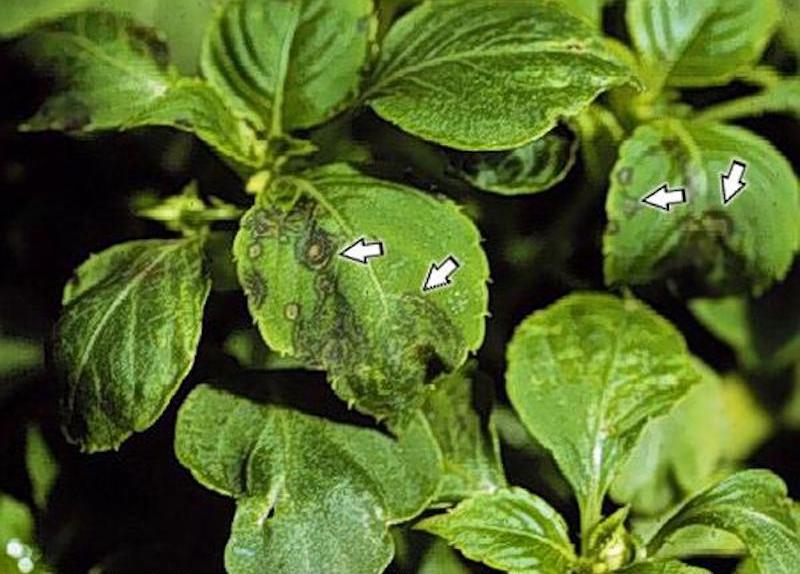
Photo by James Baker, NC State University
Treating Western Flower Thrips on Impatiens
Several natural predators of Western Flower Thrips can help keep their numbers under control in the garden. Encourage beneficial insects by providing a habitat for them to live, eat, and breed year-round. Plants growing in the greenhouse will need monitoring to determine pest population levels. You can hang yellow sticky cards to attract and trap Western Thrips. Horticultural oil sprays such as NEEM oil can be used to control larger outbreaks, although they should be used only as directed by the manufacturer. Systemic pesticides should be avoided due to the danger they pose to both pests and beneficial insects.
Preventing Western Flower Thrips on Impatiens
Only grow Impatiens in their preferred conditions, including part to full shade, well-draining soil, and a neutral pH. Deadhead the larger flowering types of Impatiens to remove spent flowers before they can cause issues with rot. Keep the plants evenly watered, especially when planted in containers or hanging baskets. Fertilize on a regular schedule with a balanced fertilizer or one that is specifically formulated for flowering plants.
Serpentine Leafminer
Leafminers in the garden are attracted to a wide range of plants, both edible and ornamental. The adult leafminer feeds on the sap of leaves by puncturing the top side. Serpentine Leafminers are gold with black backs and wings. The life cycle is very short and many generations can be hatched throughout a growing season. Affected leaves will have white stippling from the feeding adults. The eggs of the next generation are laid between the layers of the leaf. After hatching, the nymphs eat the tissue inside the leaf and leave white-colored trails all over the leaf. Healthy, mature plants are rarely seriously harmed and will recover fully.
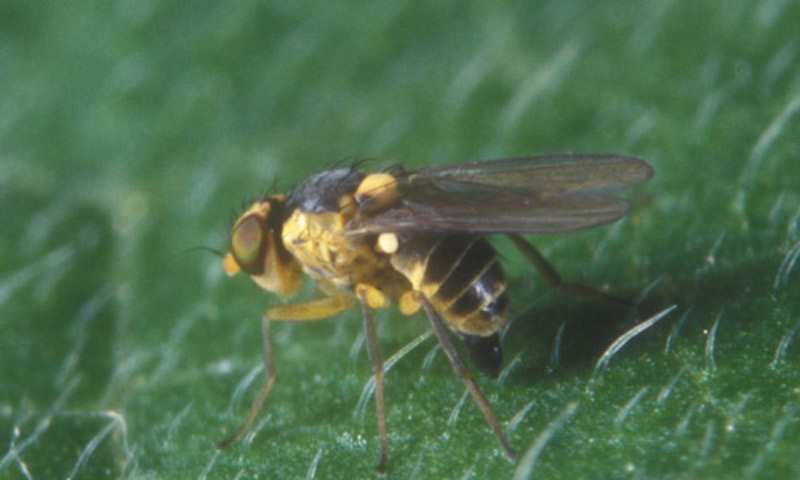
Photo by Lyle Buss
Treating Serpentine Leafminer on Impatiens
The best and really only treatment for Leafminers is to remove any damaged foliage. The damage they do is mostly cosmetic and rarely cripples the plant. Throw away any affected foliage in the trash to keep leafminers from overwintering in your compost pile. Insecticides are rarely effective for treating Leafminers.
Preventing Serpentine Leafminer on Impatiens
Leafminer damage can be prevented by growing strong, healthy plants that can resist infestations of pests. Keep Impatiens well watered at all times. Although Impatiens are quickly revived if they are underwatered, repeated dehydration cycles will weaken the plant.
Two Spotted Spider Mites
Spider Mites are much more of a threat in climates with hot dry weather. The Two Spotted Spider Mite, Tetranychus urticae, is part of the Arachnid family even though it has the same feeding habits as sap-sucking insects such as aphids and mealybugs. Ornamental plants such as Impatiens and other annuals can be seriously damaged if the outbreak is high. The Spider Mites suck sap from the leaves, leaving spotted and stippled marks. As the outbreak increases, the Mites spin dense webbing between the branches of the plant, eventually reducing the rate at which the plant can photosynthesize.
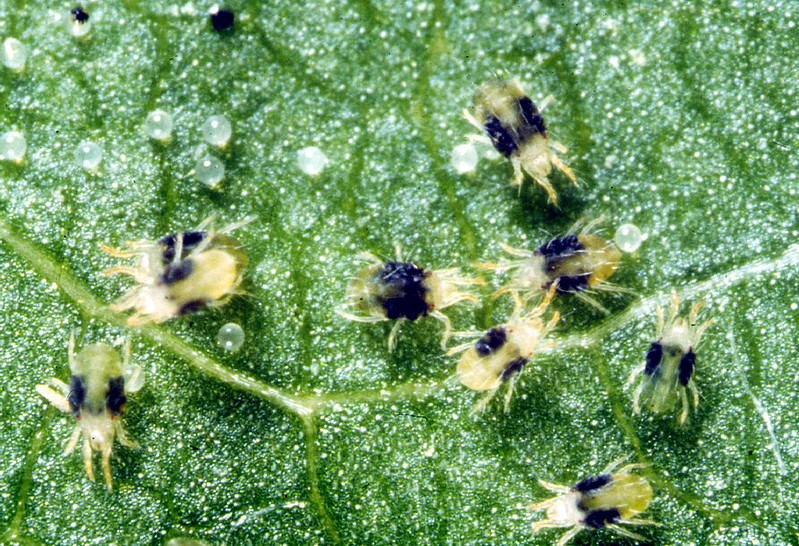
Photo posted by K-State Research and Extension, courtesy of CSIRO, unmodified, Flickr, Copyright CC BY 2.0
Treating Two Spotted Spider Mites on Impatiens
Insecticidal Soaps or NEEM oil can be used to reduce a large outbreak of Spider Mites. Often the first signs of an infestation are the webs and leaf damage, which indicate the population is already large. Over the course of a summer, during dry weather, many generations of mites can be reproduced. Remove all affected plant material if possible to get rid of both mites and their webbing.
Preventing Two Spotted Spider Mites on Impatiens
Spider Mites often invade during dry weather and attack a plant that has been stressed and weakened from bad watering habits. Impatiens require consistently moist soil in both the garden and a container. Applying organic mulch around the base of the plant helps to conserve moisture and deter Spider Mites who prefer dry, dusty soil to live in.
Japanese Beetles
Japanese Beetles are the thorn in the side of many gardeners, especially those east of the Rocky Mountains. These shiny green and copper relatives of the Scarab beetle cause mass destruction during their short time as adults in the summer.
During mid to late June, the adult beetles emerge from the ground to fly from garden to garden, feeding on a long list of ornamental and edible plants. The beetles skeletonize the leaves and destroy flowers either in bud or full bloom. During this period of feeding and mating, the females lay between 40 and 60 eggs a piece in well-manicured turf lawns. After around 40 days, all of the adults die off, leaving the eggs to hatch into grubs that feed on the roots of your grass until they pupate in the late spring and reemerge as adults.
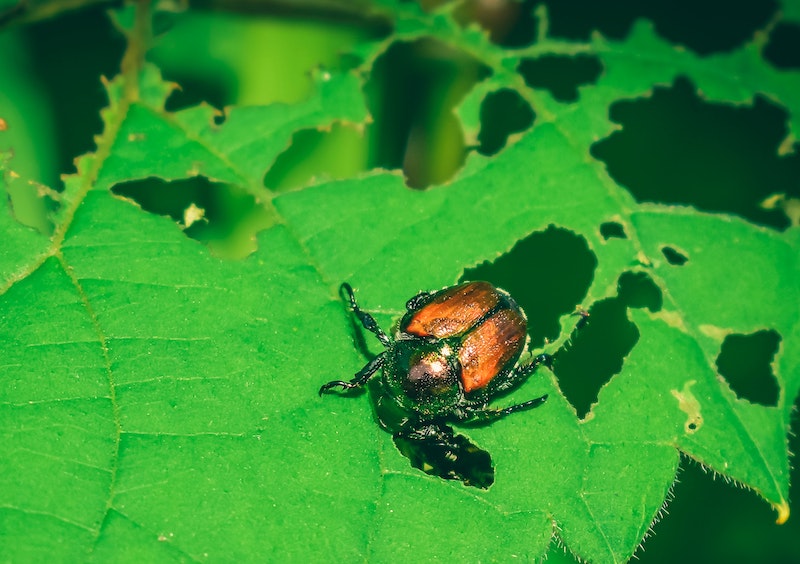
Treating Japanese Beetles on Impatiens
Treating Japanese Beetles can sometimes seem like a never-ending task. Just remember that outbreaks do not last all summer, and certain measures can be taken to protect your plants during this time. There are repellent sprays that make plants unpalatable to the beetles. Repellents used in rainy climates will have to be reapplied very regularly. You can cover specimen plants or containers with Remay horticultural fabric or insect netting during the period the beetles are active, usually about 6 weeks. Another control method, pheromone traps work very well in attracting potential mating beetles but need to be placed a great distance from the plants you want to protect. Small infestations of Japanese Beetles can be hand picked off the plants and thrown in a bucket of soapy water. At the end of the season, you can prune away any damaged plant material.
Preventing Japanese Beetles on Impatiens
Prevention is not an easy task in some parts of the country. Even if you are successful at getting rid of the grubs from your lawn, adult beetles can fly great distances from garden to garden. Reducing the number of grubs in your lawn will naturally reduce the amount of adult beetles the following season. Milky Spore is a bacteria that only affects the grubs. Applying the granular treatment in late summer will target the first groups of pupating grubs. Milky Spore also stays active in your soil for a few years, making it an effective, long-term treatment.
Gastropods
Slugs and snails enjoy the tender foliage and soft stems of impatiens. Impatiens grow best is in the shade with consistently moist soil, just the ideal spot for slugs and snails to spend time during the day. Slugs and snails often do moderate damage to mature plants, but newly planted seedlings can be decimated in the course of a night. The tell-tale ragged-edged leaves and shiny slime markings on the soil early in the morning let you know that the gastropods are lurking somewhere, waiting for nighttime to feed again.
Treating Gastropods on Impatiens
Slugs and snails become active in early spring, as your plants begin to grow, and continue to feed until the first hard frost of fall. Setting traps of shallow saucers (or tuna cans) with beer or some other liquid will help you collect many slugs and snails even in one night. Remember to empty and refill the traps every morning. Nighttime patrols with a flashlight are a great way to get your kids involved in hunting for slugs and snails. When you see one, throw it in a bucket of soapy water.
Only use chemical slug baits that are made from iron phosphate. These baits are safe to use around pets, children, birds, and fish. The iron phosphate dries out the slug or snail, causing them to die. Physical barriers such as crushed eggshells or diatomaceous earth work for short periods but will need to be reapplied after heavy rains.
Deer
Deer love Impatiens. The flowers and tender new foliage growth are their favorite bits to browse in your garden. Often the only sign that a deer has browsed on your Impatiens is an empty hole where the plant once resided. Deer nibbling is done by tearing with their front teeth, so any remaining plant parts will have a ragged edge, not a smooth one as rabbits leave behind.
Treating Deer Damage on Impatiens
Larger Impatien plants can recover if they are only lightly nibbled. Smaller plants may not have enough foliage left to photosynthesize and continue growing. Many repellent sprays are effective on plants for a short time. Deer become acclimated to the smells and will resume their browsing habits on your plants. Changing brands and active ingredients is one way to keep deer at bay.
Using systemic bittering agents when planting Impatiens will protect them from browsing, often for the whole growing season. Try mixing Repellex Systemic granular treatment into the soil either at planting or later as a top-dressing. The active ingredients are absorbed by the plant and make it unappealing for the deer to eat. This is an effective treatment for container-grown plants and hanging baskets that may be in the roaming path of local deer.
Preventing Deer Damage on Impatiens
Keeping deer from eating Impatiens and other prized plants is not easy and is an ongoing challenge for gardeners living in areas with high deer populations. Not growing Impatiens in the roaming path of your local deer is one solution. Deer are creatures of habit and very lazy. They tend to have well-worn daily paths through your garden and around your community. Plant Impatiens in hanging baskets or planters placed close to the front door, patio, or deck. Deer typically avoid areas near people, like the entrance to a house, and they can’t reach pots on a second-story deck.
Impatiens Pests Chart
|
Pest |
Identifying |
Treating |
|
Root Knot Nematodes |
Yellowing of the foliage, slowed plant growth, failure to flower properly, and flowers dropping off the plant without opening |
Completely remove the plant before the Nematodes can spread |
|
Melon Aphid |
Orange-yellow color of the young nymph stage |
A sharp blast of water from a hose and holticultural |
|
Greenhouse Whitefly |
Soft-bodied sap-sucking insects, creamy white color for all of its life stages |
Strong jet of water from the hose |
|
Western Flower Thrips |
Stippled coloring, deformed and twisted leaf growth, leaf rolling, changes in flower coloring, or a rough look to the flower after it opens |
Hang yellow sticky cards to attract and trap; use holticultural oil |
|
Serpentine Leafminer |
Gold with black backs and wings |
Remove any damaged foliage, throw away any affected foliage in the trash |
|
Two Spotted Spider Mites |
Oval-shaped bodies, usually pale green or yellow with two dark spots on their back |
Use insecticidal Soaps or NEEM oil |
|
Japanese Beetles |
Shiny green and copper relatives of the Scarab beetle |
Hand picked off the plants and thrown in a bucket of soapy water |
|
Gastropods |
Tell-tale ragged-edged leaves and shiny slime markings on the soil |
Set traps of shallow saucers (or tuna cans) with beer or some other liquid |
|
Deer |
Nibbling is done by tearing with their front teeth, so any remaining plant parts will have a ragged edge |
Using systemic bittering agents when planting Impatiens |
Sources:
"Impatiens (Impatiens)." Connecticut State - The Connecticut Agricultural Experiment Station. portal.ct.gov/
"Impatiens, New Guinea impatiens—Impatiens wallerana, Family Balsaminaceae (Balsam family)." University of California Integrated Pest Management. ipm.ucanr.edu
 |
Author Robbin Small - Published 7-30-2023 |
